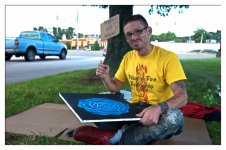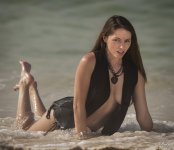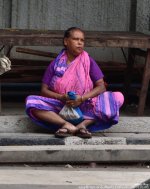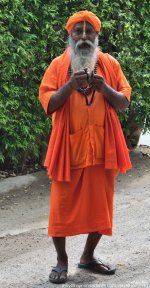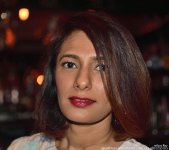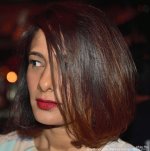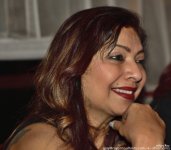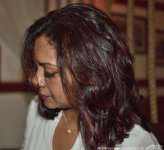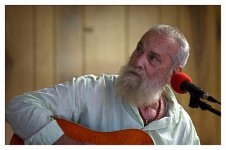You did well in exposure, it is always tricky with dark black or brown skin to get good color richness with the underexposure needed to keep it realistically dark. Shine is the bigger problem, hard to get away from regardless of how diffused the light is. If one uses manual exposure it is easier to meter and drop exposure 2 stops or so. Our meters want everything middle grey so overexposes dark skin and black suits or tux, for the same reason it wants white satin dresses and snowfields to be grey. Yesterday I shot a few photos of a girl from Brazil who was in the crowd waiting to get into a special event for the World Cup that is being staged here and 11 other cities in Russia. I was taken so by her rich smooth mocha colored skin, but in the sun it was hard to capture the right tone due to too much light so I had her boyfriend hold a map over her head to shadow her face. It turned out really nice, beautiful girl with stunning skin. She had me promise not to let anyone else see them so I can't post one. I spot metered the whites of her eyes and bright white teeth then the darkest tones of her shadowed skin and split the difference for a manual exposure of -2.66 below her eyes.
You are using an out of date browser. It may not display this or other websites correctly.
You should upgrade or use an alternative browser.
You should upgrade or use an alternative browser.
Post your Portrait shots!
- Thread starter Rick M
- Start date
Here is one I took of Brazilian, originally from South Africa, who asked for a photo in a pub where I was having a bite to eat. The same sort of thing, as discussed above, getting enough under-exposure to give realistic skin tones with darker skin. This was easier since my flash was 80% of the light and under my control.
He was with a group who had just watched his team win again. The whole city is a gigantic party, with an extra 1/2 million football fans. For most of them, this is their first visit to Russia and I am sure it will spawn even more tourism since everything they have been told, they see with their own eyes, was wrong. Hanging out with many fan groups has been fun, everyone is in such a good mood and unlike football's reputation in the UK and other areas for hooliganism, all that is absent here, just good relations between all the rival teams and fans. From officials of FIFA I chatted with, the general feeling is that this is the best organized and best atmosphere yet for any World Cup. See, I don't only take photos of pretty young women;>)

He was with a group who had just watched his team win again. The whole city is a gigantic party, with an extra 1/2 million football fans. For most of them, this is their first visit to Russia and I am sure it will spawn even more tourism since everything they have been told, they see with their own eyes, was wrong. Hanging out with many fan groups has been fun, everyone is in such a good mood and unlike football's reputation in the UK and other areas for hooliganism, all that is absent here, just good relations between all the rival teams and fans. From officials of FIFA I chatted with, the general feeling is that this is the best organized and best atmosphere yet for any World Cup. See, I don't only take photos of pretty young women;>)

Blade Canyon
Senior Member
Shine is the bigger problem, hard to get away from regardless of how diffused the light is.
I did have that problem. Believe it or not, the photos above had a lot more shine, but I found a good tutorial on how to reduce it. Basically just create a new layer, set the blend mode to darken, and choose the color of the skin around the shine. Brush that color on the shiny areas, then adjust transparency until it looks right. There is still some shine on these, but not so bad.
john*thomas
Senior Member
Interesting photo, I like the context. One thing I would suggest since you have such a competent camera, it is expose these strong backlit images using matrix metering mode and exposure in M mode. Then since you are close, pop up the flash or better, a speed light in iTTL BL mode(which is automatic when metering is in Matrix mode) and take the shot. BL mode would meter the subject, by the metering circuit in the flash. That would produce an image where the background is not blown out but the subject is well exposed, because of coordination between the subject metering the flash and scene exposure metering in Matrix mode. That would bring out the details of his face which surely tells more of the story. Otherwise, another option is to expose his face based on Spot metering right on his cheekbone that is an upper mid-tone normally. This would provide a fully blown out background that would make him, properly exposed the uncontested subject of the frame.
In the first method, the facial tones will be better balanced than conventional camera mounted direct flash because the flash only has to add a fraction of its power to simple fill, with the main exposure light being the ambient, so it does not produce the dreaded "Flash Face", direct flash mounted only 2 inches above the center axis of the lens.
In the first method, the facial tones will be better balanced than conventional camera mounted direct flash because the flash only has to add a fraction of its power to simple fill, with the main exposure light being the ambient, so it does not produce the dreaded "Flash Face", direct flash mounted only 2 inches above the center axis of the lens.
john*thomas
Senior Member
Interesting photo, I like the context. One thing I would suggest since you have such a competent camera, it is expose these strong backlit images using matrix metering mode and exposure in M mode. Then since you are close, pop up the flash or better, a speed light in iTTL BL mode(which is automatic when metering is in Matrix mode) and take the shot. BL mode would meter the subject, by the metering circuit in the flash. That would produce an image where the background is not blown out but the subject is well exposed, because of coordination between the subject metering the flash and scene exposure metering in Matrix mode. That would bring out the details of his face which surely tells more of the story. Otherwise, another option is to expose his face based on Spot metering right on his cheekbone that is an upper mid-tone normally. This would provide a fully blown out background that would make him, properly exposed the uncontested subject of the frame.
In the first method, the facial tones will be better balanced than conventional camera mounted direct flash because the flash only has to add a fraction of its power to simple fill, with the main exposure light being the ambient, so it does not produce the dreaded "Flash Face", direct flash mounted only 2 inches above the center axis of the lens.
I appreciate the suggestions, seriously I do. I have a friend that is an amazing photographer.
https://digital-photography-school.com/author/brucewunderlich/
I love to be around him when he is doing his thing as I always pick up something I can use even though to me it's not really about the process. Sometimes I will take my time, adjust my settings, if it's not right, do it again and again. I don't want this to come across wrong........it's not my thing. I do have a nice camera.......the nicest thing is it gets me in places. People see the camera and think you know what you are doing. It is most certainly great to know what you are doing. Bruce doesn't even think about it. It's automatic. It's cool to watch.
I did not know this guy until I walked up to ask him about what he was doing. I don't want to say "I don't know you but would you sit still for a picture while I adjust these settings"? I can show up with my 70-200 2.8 and people will get out of the way also. Even a quick, I need to get this shot is better than what I can do on my cell phone or something. For me, it's the experience far more than the process. BUT it's great that so many here can explain the process.
I gave him a few dollars and told him I would try and get his some exposure. I'll post a pic on Facebook now and then......if I get 25 likes, I'm glad that many people liked it. If I get 100 I'm trying to figure out why. I posted his pic and a little story last night and there is over 1000 likes and shares. That is what I was after.
Hopefully he sells a lot of paintings, people tell him they saw his picture on Facebook and I can then ask him to sit for a more proper pic.
I doubt your friend who is the great photographer approaches as a process either. I don't but see the scene in my mind as finished and just know how to set things based on light, shadows and perspective. Even my studio portraits are no adjustments, when seeing the scene it is as natural as driving an unknown road, automatic based on the senses. Since cameras see so differently than we perceive light color and shadows, it does take some experience a to develop the habit of seeing the scene with eyes how the camera would see it. You were standing in front of the subject and saw very different detail than a camera/display media would see it. Our eyes have lower dynamic range than we normally encounter with deepest shadows and brightest light but we perceive a lot of information both in deep shadows and in bright areas became the eye is not like a camera, is more like a camera with multiple exposures at different apertures and shutter speeds that the brain uses to composite into a wider DR perception. Our brain creates the image from many scans, so we can see detail close up and far, but not at the same instant in the same way our eyes adjust dynamically to light level so over multiple sets of data from the retina with small pupil and large we create a composite of shadow detail with open iris and highlight capture with stopped down iris. Knowing that, with some experience, we naturally "see" or imagine who the camera would have seen it and just know what settings will result in what you expected to see.
The same with many crafts that are taught by rote but becomes second nature only with experience. Beginning drivers are happy just to get down the road without an accident but with enough experience it is a nonthinking activity of managing the car as an extension of one's self.
The same with many crafts that are taught by rote but becomes second nature only with experience. Beginning drivers are happy just to get down the road without an accident but with enough experience it is a nonthinking activity of managing the car as an extension of one's self.
I have not been posting much lately, busy tourist season in my incoming tour company but went for a walk in a park with my friend while we were waiting for her young friend to join us I took a few photos of her and then of her friend. Both are actors on stage and movies here. The younger girl(19 yo) wanted a headshot for a casting director, just a snapshot to attach to her datasheet. I never met Polina before so was not sure what image she wanted to express or what part she was trying for. So this was just a 1 flash headshot with the bright sun at the evening horizon. The background was very bright so with her in shadows, just pointed the shoe-mounted flash directly at her. She was dressed conservatively so I assumed she wanted to look older more adult so just an office style headshot

Then I took a few of my friend who is almost twice Polina's age: This one was just before entering a restaurant in the park with wide open aperture to get rid of the distracting background. The new 56mm flange Z mount is going to allow taking subject isolation images in any environments, can't wait to try the 58 f/0.95 Since the light colored granite wall behind her was so bright I put her in the shadow and had Polina hold the flash 4 feet to my left set for iTTL-0.7 and it balanced the bright background pretty well. Despite the uproar of internet chatter about single card slot(a XQD is more reliable than any pair of SD cards), the new mount and simpler optics it allows is going to be a game changer for portraiture and general flexibility with a new class of primes. I was not originally interested in mirrorless but the mount separates the pretenders from the real deal, which is lost with all the keyboard-warriors having fits over a single slot. I will get the Z7 when the 85 1.2 is released and go take photos of all my friends until they get tired of seeing that camera;>) I will keep my D800 workhorse or maybe swap it for a D850 for everything else. Overall, the D850 is the nest FF camera made.
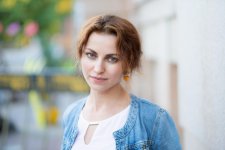

Then I took a few of my friend who is almost twice Polina's age: This one was just before entering a restaurant in the park with wide open aperture to get rid of the distracting background. The new 56mm flange Z mount is going to allow taking subject isolation images in any environments, can't wait to try the 58 f/0.95 Since the light colored granite wall behind her was so bright I put her in the shadow and had Polina hold the flash 4 feet to my left set for iTTL-0.7 and it balanced the bright background pretty well. Despite the uproar of internet chatter about single card slot(a XQD is more reliable than any pair of SD cards), the new mount and simpler optics it allows is going to be a game changer for portraiture and general flexibility with a new class of primes. I was not originally interested in mirrorless but the mount separates the pretenders from the real deal, which is lost with all the keyboard-warriors having fits over a single slot. I will get the Z7 when the 85 1.2 is released and go take photos of all my friends until they get tired of seeing that camera;>) I will keep my D800 workhorse or maybe swap it for a D850 for everything else. Overall, the D850 is the nest FF camera made.

john*thomas
Senior Member
Andy W
Senior Member
Stan, was this one iTTL as well?
Yes, being a quick shot there was no time for a trial and error to balance exposure. When in controlled conditions I prefer manual flash control but iTTL works so well generally it is a good first try. I suggest that people starting with manual exposure or flash can get a good idea of starting settings by put it into Green auto and see what the camera calculated. After a few different lighting conditions one should have a very good estimation for initial settings for full manual exposure. 80% of the time my cameras are in M mode simply because I want specific DOF and shutter speed based on the subject. In rapidly changing conditions I might put it into Auto ISO mode. In the studio everything is manual for each light, aperture and shutter.
Of all the flash systems out there, iTTL and CLS is the most advanced.
Of all the flash systems out there, iTTL and CLS is the most advanced.
Blade Canyon
Senior Member
. In rapidly changing conditions I might put it into Auto ISO mode.
I hate Auto-ISO when using a speedlite. It makes strange decisions and seems to opt for the highest ISO it can. Maybe it's a firmware strategy to save the flash batteries...
Yes, I hope I did not give the impression that I use auto ISO with flash. It does not work as one might expect and can't since it has no information to work with that reflects the light conditions when the flash triggers. I was referring to general shooting when needing to control DOF and account for subject speed. That is a case where it is convenient to use Auto ISO and manual exposure ....without flash at all.
In fact I never use any auto exposure mode, only manual exposure when using flash. Using flash allows you so set everything for optimum subject conditions in manual mode...ISO for DR preservation vs flash power needed, shutter for controlling ambient light, and aperture for DOF and setting ratio of room/scene ratio to subject illumination. iTTL BL mode is one of the coolest features of Nikon flash and exposure interaction. Love it. All flash usage is manual exposure. Very easily, you can create the impact of the background versus subject exposure. Want to isolate a subject in a crowded room...no problem set the exposure without flash to -6stops and turn on the flash for iTTL BL in Matrix and bingo, well lit subject and a black background and the other people in the restaurant or event disappear just as an example. Or doe the opposite set the metering in Matrix to decent exposure, by dropping shutter speed and let the flash freeze the subject and balance the exposure of slowly exposed dark background scene and your flash Rear Curtain, fires at the end of the long background exposure of say 1/10sec and the flash freezes the subject proper exposure. A lot of flexibility with very little effort.
In fact I never use any auto exposure mode, only manual exposure when using flash. Using flash allows you so set everything for optimum subject conditions in manual mode...ISO for DR preservation vs flash power needed, shutter for controlling ambient light, and aperture for DOF and setting ratio of room/scene ratio to subject illumination. iTTL BL mode is one of the coolest features of Nikon flash and exposure interaction. Love it. All flash usage is manual exposure. Very easily, you can create the impact of the background versus subject exposure. Want to isolate a subject in a crowded room...no problem set the exposure without flash to -6stops and turn on the flash for iTTL BL in Matrix and bingo, well lit subject and a black background and the other people in the restaurant or event disappear just as an example. Or doe the opposite set the metering in Matrix to decent exposure, by dropping shutter speed and let the flash freeze the subject and balance the exposure of slowly exposed dark background scene and your flash Rear Curtain, fires at the end of the long background exposure of say 1/10sec and the flash freezes the subject proper exposure. A lot of flexibility with very little effort.


